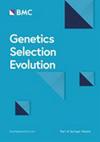Genetic parameters and genotype-by-environment interaction estimates for growth and feed efficiency related traits in Chinook salmon, Oncorhynchus tshawytscha, reared under low and moderate flow regimes
IF 3.1
1区 农林科学
Q1 AGRICULTURE, DAIRY & ANIMAL SCIENCE
引用次数: 0
Abstract
A genotype-by-environment (G × E) interaction is defined as genotypes responding differently to different environments. In salmonids, G × E interactions can occur in different rearing conditions, including changes in salinity or temperature. However, water flow, an important variable that can influence metabolism, has yet to be considered for potential G × E interactions, although water flows differ across production stages. The salmonid industry is now manipulating flow in tanks to improve welfare and production performance, and expanding sea pen farming offshore, where flow dynamics are substantially greater. Therefore, there is a need to test whether G × E interactions occur under low and higher flow regimes to determine if industry should consider modifying their performance evaluation and selection criteria to account for different flow environments. Here, we used genotype-by-sequencing to create a genomic-relationship matrix of 37 Chinook salmon, Oncorhynchus tshawytscha, families to assess possible G × E interactions for production performance under two flow environments: a low flow regime (0.3 body lengths per second; bl s−1) and a moderate flow regime (0.8 bl s−1). Genetic correlations for the same production performance trait between flow regimes suggest there is minimal evidence of a G × E interaction between the low and moderate flow regimes tested in this study, for Chinook salmon reared from 82.9 ± 16.8 g ( $${\overline{\text{x}}}$$ ± s.d.) to 583.2 ± 117.1 g ( $${\overline{\text{x}}}$$ ± s.d.). Estimates of genetic and phenotypic correlations between traits did not reveal any unfavorable trait correlations for size- (weight and condition factor) and growth-related traits, regardless of the flow regime, but did suggest measuring feed intake would be the preferred approach to improve feed efficiency because of the strong correlations between feed intake and feed efficiency, consistent with previous studies. This new information suggests that Chinook salmon families do not need to be selected separately for performance across different flow regimes. However, further studies are needed to confirm this across a wider range of fish sizes and flows. This information is key for breeding programs to determine if separate evaluation groups are required for different flow regimes that are used for production (e.g., hatchery, post smolt recirculating aquaculture system, or offshore).低流量和中流量条件下饲养的大鳞鲑(Oncorhynchus tshawytscha)生长和饲料效率相关性状的遗传参数和基因型与环境相互作用估计值
基因型与环境的相互作用(G × E)是指基因型对不同环境的不同反应。在鲑科鱼类中,G × E 相互作用可能发生在不同的饲养条件下,包括盐度或温度的变化。然而,水流是影响新陈代谢的一个重要变量,虽然不同生产阶段的水流不同,但尚未考虑潜在的 G × E 相互作用。目前,鲑鱼养殖业正在控制水箱中的水流,以提高福利和生产性能,并在近海扩大海栏养殖,因为那里的水流动态更大。因此,有必要测试在低流量和高流量条件下是否会发生 G × E 相互作用,以确定该行业是否应考虑修改其性能评估和选择标准,以适应不同的流量环境。在此,我们使用基因型测序方法创建了 37 个大鳞大麻哈鱼(Oncorhynchus tshawytscha)家系的基因组关系矩阵,以评估在两种水流环境(低水流环境(0.3 体长/秒;bl s-1)和中水流环境(0.8 bl s-1))下生产性能可能存在的 G × E 相互作用。对于饲养体重从 82.9 ± 16.8 g($${overline{text{x}}$±s.d.)到 583.2 ± 117.1 g($${overline{text{x}}$±s.d.)的大鳞大麻哈鱼而言,不同水流条件下同一生产性能特征的遗传相关性表明,在本研究测试的低水流条件和中等水流条件下,G × E 相互作用的证据极少。)对性状间遗传和表型相关性的估计并未发现任何不利于体型(体重和体况因子)和生长相关性状的性状相关性,与水流制度无关,但由于采食量和饲料效率之间的强相关性,表明测量采食量将是提高饲料效率的首选方法,这与之前的研究一致。这一新信息表明,大鳞大麻哈鱼家族不需要在不同水流条件下分别进行性能选择。不过,还需要进一步研究,以便在更广泛的鱼体大小和水流范围内证实这一点。这些信息对育种计划至关重要,有助于确定是否需要对用于生产的不同水流条件(如孵化场、蜕皮后循环水产养殖系统或近海)进行单独的评估分组。
本文章由计算机程序翻译,如有差异,请以英文原文为准。
求助全文
约1分钟内获得全文
求助全文
来源期刊

Genetics Selection Evolution
生物-奶制品与动物科学
CiteScore
6.50
自引率
9.80%
发文量
74
审稿时长
1 months
期刊介绍:
Genetics Selection Evolution invites basic, applied and methodological content that will aid the current understanding and the utilization of genetic variability in domestic animal species. Although the focus is on domestic animal species, research on other species is invited if it contributes to the understanding of the use of genetic variability in domestic animals. Genetics Selection Evolution publishes results from all levels of study, from the gene to the quantitative trait, from the individual to the population, the breed or the species. Contributions concerning both the biological approach, from molecular genetics to quantitative genetics, as well as the mathematical approach, from population genetics to statistics, are welcome. Specific areas of interest include but are not limited to: gene and QTL identification, mapping and characterization, analysis of new phenotypes, high-throughput SNP data analysis, functional genomics, cytogenetics, genetic diversity of populations and breeds, genetic evaluation, applied and experimental selection, genomic selection, selection efficiency, and statistical methodology for the genetic analysis of phenotypes with quantitative and mixed inheritance.
 求助内容:
求助内容: 应助结果提醒方式:
应助结果提醒方式:


